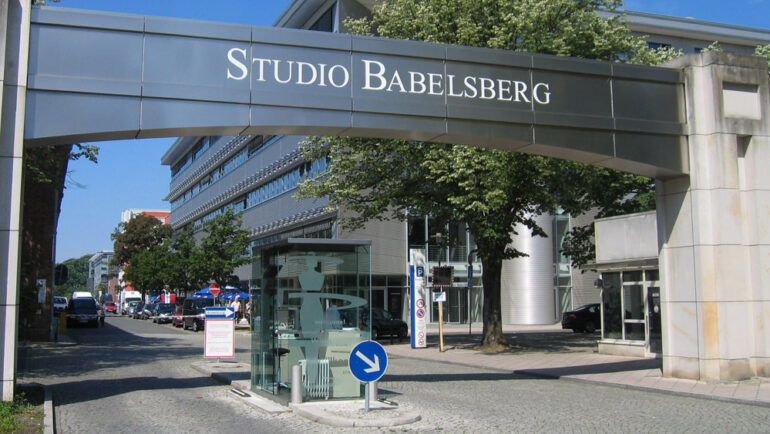1912 TO 1921 – THE BEGINNINGS
On February 12th, 1912, in a glass-house atelier, shooting began on the silent movie DER TOTENTANZ starring Asta Nielsen – thus marking the birth of Studio Babelsberg. Deutsche Bioscop Filmge-
sellschaft had discovered the old factory complex located just outside of Berlin, and it soon became a vibrant center of the silent film production thanks to its optimal production conditions, which in-
cluded plenty of space and non-haze daylight. The studio produced such classics as DER STUDENT VON PRAG (1913), DER GOLEM (1915), NOSFERATU (1922), DER LETZTE MANN (1924) by Friedrich
Wilhelm Murnau and Fritz Lang’s DOKTOR MABUSE (1922). Babels berg was also home to the world’s first movie stars: Henny Porten, Lilian Harvey, Pola Negri and Paul Wegener.
1921 TO 1932 – THE GOLDEN 20S
In 1921, the site became the property of Universum Film AG (UFA), which had been founded in 1917. In 1926, this company built a large studio – now called the “Marlene Dietrich Hall” for the large-
scale production of METROPOLIS by Fritz Lang. The next chapter in cinema history came in Babelsberg in 1929 with the setting-upof the first sound-film studio in Europe, the “Tonkreuz”. MELODIE DES HERZENS starring Willy Fritsch was Germany’s first full-length feature film with sound from start to finish. This was followed up in 1930 with the first screening of Josef von Sternberg’s DER BLAUE ENGEL starring Marlene Dietrich and Emil Jannings.
1933 TO 1945 – BABELSBERG GOES TO HOLLYWOOD
The economic hardships at the end of the 1920s pushed UFA to the edge of bankruptcy. After the Nazis’ accession to power in 1933, a number of Nazi propaganda films were made under the auspices
of the “Ministry for Public Enlightenment and Propaganda.” Filmmakers such as Josef von Sternberg, Fritz Lang, Ernst Lubitsch, Billy Wilder and stars such as Marlene Dietrich would leave Germany
to try their luck in Hollywood. During this era, the main task of Babelsberg Studios was the production of entertainment films designed to distract German audiences from war-related difficulties. Among the films made in this era were MÜNCHHAUSEN (1943) and FEUERZANGENBOWLE (1944), the latter still being popular today. The stars of the era are Zarah Leander, Heinz Rühmann and Hans Albers.
1946 TO 1990 – DEFA
After World War II, it didn’t take long before the studio got a new lease on life. Already on May 4th, 1946, shooting on the first film started: Wolfgang Staudte’s DIE MÖRDER SIND UNTER UNS starring
Hildegard Knef. On May 17th, 1946, the German-Soviet corporation DEFA (Deutsche Film AG) was founded. The studio became the exclusive venue of feature film production in the GDR and soon
advanced – with roughly 2,500 employees – to become the largest employer in the region. From 1946 to 1990, the studio saw the production of more than 1,200 feature films and TV films of various
artistic and political orientations, including DAS KALTE HERZ (1950), DER UNTERTAN (1951), DIE GESCHICHTE VOM KLEINEN MUCK (1953), NACKT UNTER WÖLFEN (1963), DAS SINGENDE,
KLINGENDE BÄUMCHEN (1957), DAS KANINCHEN BIN ICH (1965), SPUR DER STEINE (1966), DIE LEGENDE VON PAUL UND PAULA (1973), SOLO SUNNY (1980) and COMING OUT (1989). In 1976,
JAKOB DER LÜGNER becomes the only GDR film to be nominated for an Oscar.
1990 TO TODAY – HOLLYWOOD COMES TO BABELSBERG
In August 1992, the former DEFA film studio was sold to the French corporation Compagnie Générale des Eaux (today: Vivendi Universal). In the following years, the company would invest roughly 500 million in the studio and the surrounding media city. The current CEOs, Charlie Woebcken and Christoph Fisser, took over in July 2004 and expanded the site by means of large-scale industrial halls, thus driving forward the internationalization of the site’s productionservices. 2007 became the most successful business year since theprivatization of the company – 12 German and international feature
films were produced in that year, among others THE READER, VALKYRIE and THE BOURNE ULTIMATUM. In 2009, Quentin Tarantino shot his INGLOURIOUS BASTERDS here. From this point
on, Studio Babelsberg was on Hollywood’s radar, and there was an influx of stars: Kate Winslet, Tom Cruise, George Clooney, Cate Blanchett, Tom Hanks, Bill Murray, Brad Pitt, Diane Kruger, John
Goodman, Tilda Swinton, Adrien Brody, Ralph Fiennes, Matt Damon, Ryan Reynolds, Liam Neeson, Harvey Keitel and many more made their way to Babelsberg to work with the world’s most famous
directors – Wes Anderson, Steven Spielberg, Roman Polanski and more. Among the most successful films and series made at Babelsberg are THE INTERNATIONAL, THE GHOST WRITER, UNKNOWN
IDENTITY, WER IST HANNA?, GRAND BUDAPEST HOTEL, MONUMENTS MEN, THE BOOK THIEF, THE TRIBUTE OF PANEM: MOCKINGJAY, BRIDGE OF SPIES, THE FIRST AVENGER: CIVIL WAR, HOMELAND, A CURE FOR WELLNESS, BERLIN STATION and more. Since 2003, productions completed at Studio Babelsberg have received 48 Academy Award nominations and taken home 15 Oscars in different categories.
(Courtesy of Picture Tree International)


